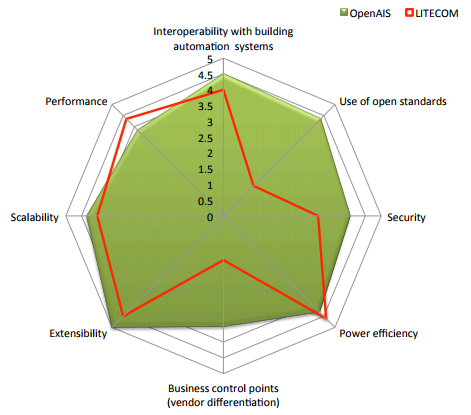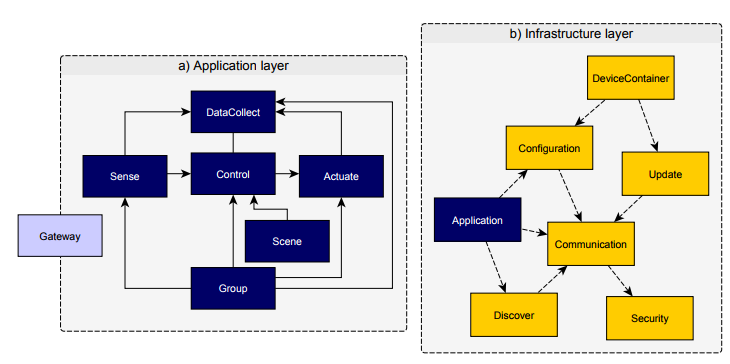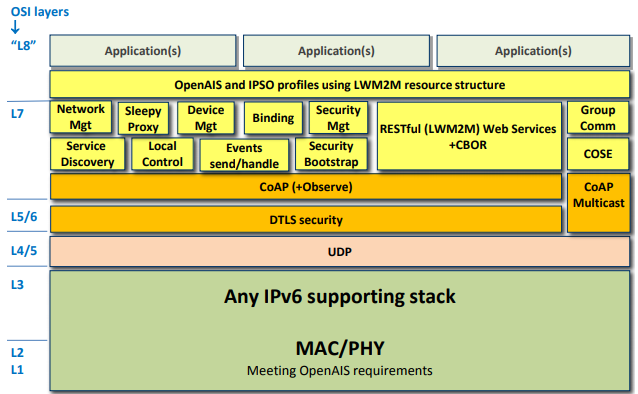ABSTRACT
The Internet of Things (IoT) is opening up new services and is stimulating changes in industries. The lighting industry is also embracing this change by establishing an Internet of Lights (IoL). This article highlights the main benefits and the challenges to face while going towards IoL. To address these challenges and cater to the specific requirements of lighting networks, an IoL reference architecture, Open Architecture for Intelligent Solid State Lighting Systems (OpenAIS), has been proposed. This article provides an overview of the OpenAIS architecture and explains how one can design specific systems based on this architecture.
It also zooms into the configurations and design choices made in a pilot system in a real office building showing the validity of the architecture. A comparison of the OpenAIS system with a state-of-the-art commercial solution shows that IoL systems can exceed proprietary systems in several key performance indicators, such as security, interoperability, extensibility and openness.
MOTIVATION
- Existing Lighting Standards
- Goals of the IoL Standard
- New Challenges in IoL
Existing Lighting Standards
Over the years, numerous standards have been developed for lighting systems and building automation such as DALI, BACnet, KNX, LonWorks and Modbus. Some are them more specialized, e.g., DALI is used for lighting controls, and Modbus is designed primarily for industrial control; whereas others, such as BACnet, KNX and LonWorks, are more general and can be used for the control of the whole building. Building automation could use DALI for lighting and BACnet, KNX or LonWorks for controlling the rest.
Goals of the IoL Standard
IP-based: Using a general communication protocol such as IP facilitates a flexible service-oriented approach. Many types of services can share the same network at the same time. Heterogeneous devices and protocols are allowed in IP. The end-to-end connectivity property of IP provides basic interoperability where devices can communicate without protocol translation, and data can be shared across many systems. A wide variety of software and tools, e.g., diagnostics and management tools, are now available, and the IP system can benefit from the developments and innovations of a worldwide community. Moreover, IP offers much better security.
New Challenges in IoL
Performance: Moving away from today’s dedicated lighting network to an IT network with cloud-based communication of IoT raises several questions. Ensuring reliability and guaranteed performance of dedicated lighting systems in an Internet-connected luminaires’ world is the key issue to solve.
OPENAIS IOL ARCHITECTURE
The relations between the infrastructure layer functions shows that the Application function (could be any one of the application layer functions like Sense, Actuate or Control) is configured by the Configuration function, while it makes use of the Communication function for application-level communications and the Discovery function for detecting available functions.
The dependency relationship, function A uses B, is shown with a directed dashed edge from A to B in Figure 1. The Device Container function uses the Configuration function for parameter settings and the Update function for software update. Discovery, Update and Configuration functions make use of the Communication function for communication, which in turn uses the Security function to make the communication secure.
(a) Object Data Model hierarchy; (b) An example of a device with various Object types.
Figure 2a shows the hierarchy between the Device, the Object, the Object instance and the entailed Resources. OpenAIS Objects could be of the type Physical or Logical. A Physical Object represents one hardware instance (e.g., a light-point, a sensor) and controls the associated physical effects. A Logical Object represents one controlled aspect of a hardware instance (e.g., intensity, color, sensor).
A hardware instance can have only one Physical Object instance, but may have multiple logical instances as shown in Figure 2b. The Device Object shown in Figure 2b features the Device Container functionality of OpenAIS and represents the whole device. Therefore, there is a one-to-one relationship between the device and the Device Object. In addition to the illustrated Objects in Figure 2b, OpenAIS also defines Organizational Objects (e.g., Group, Security) and Functional Objects (e.g., BasicControl, Scene, DataCollect).
OpenAIS IoL supports both wired and wireless networks and mandates IPv6 communication for all end nodes. IPv6 is the main decoupling point in the architecture, as the underlying physical, data-link layer stack choices are not mandated; instead, default choices have been proposed in the reference implementation, which are Thread for wireless and Ethernet for wired networks. The envisaged network stack is depicted in Figure 4.
SYSTEM SOLUTION
To validate the OpenAIS IoL architecture, the OpenAIS project is progressing with a pilot system installation in a real office at a premier building. The lifecycle of the OpenAIS system starting from the component and system design to use and maintenance is shown in Figure 5. It illustrates the five phases of the lifecycle and related requirements. In this section, a deeper insight into certain aspects of the system solution within the scope of the article is presented.
SYSTEM ANALYSIS

Figure 6. OpenAIS pilot implementation vs.LITECOM scored based on the opinion of a team of experts in both systems
A comparison of OpenAIS pilot and LITECOM based on eight criteria is shown Figure 6. The evaluation is undertaken by the designers of both architectures, according to a list of decision-making criteria, which is generated by intelligence lighting domain experts. The spider diagram shows that the OpenAIS system exceeds LITECOM in all KPIs evaluated except for performance and power efficiency. OpenAIS is really strong in:
- Use of open standards
- Security
- Business control points,i.e.,vendor differentiation
RELATED WORK
- Lighting Systems Products and Projects
- IoT Architecture and Framework
Lighting Systems Products and Projects
There is a wide range of products coming into the lighting market. Daintree Networks based on ZigBee PRO, Enlighted Inc. wireless network based on IEEE 802.15., Gooee (a full-stack IoT solution), the LITECOM lighting management system from Zumtobel, Philips Connected Office Lighting, etc., are examples of proprietary IP-based lighting systems. There are products that provide wireless extension to DALI.
IoT Architecture and Framework
There are several competing alliances led by the world’s prominent semiconductor, electronic and telecom industries resulting in various IoT platforms and frameworks. The AllSeen Alliance led by Qualcomm with more than 180 members is a popular one. The AllJoyn is an open source framework from AllSeen with a set of system services that enables interoperability among products and applications across manufacturers using a D-Bus message bus.
CONCLUSIONS
In this article, we explained how the lighting industry can benefit from IoT by moving from the traditional closed and proprietary systems to secure, extensible, interoperable and service-oriented systems. We presented an Internet of Light architecture, OpenAIS, designed to address the challenges while making this transition. An overview of the OpenAIS IoL architecture with a deeper look from different architectural perspectives has been provided. Additionally, a system solution explaining the design of a pilot system, with its configurations and design choices, has been provided.
An analysis of the system by comparing it with a state-of-the-art commercial solution shows how IoL systems can exceed proprietary systems in several KPIs such as security, interoperability, extensibility and openness. A SWOT analysis of the OpenAIS system highlighting strengths, weaknesses, opportunities and threats is also provided. The system analysis shows that despite careful design choices, the performance of the IoL is slightly lower than proprietary solutions. The transition towards IoT enables using/sharing the network infrastructure in the building instead of employing a dedicated network for each building services.
Ensuring reliability and guaranteed performance of dedicated lighting networks in shared networks will be a challenge. The security and privacy of IoL is an issue not fully resolved. Careful monitoring of security vulnerabilities and updating to the latest security provisions are needed. To ensure privacy, strong policies and their enforcement for data storage and handling are needed. A careful study on the impact of IoL on various stakeholders and the changes it brings in to the lighting value chain and building sector need to be carefully analyzed.
Source: Eindhoven University of Technology
Authors: Emi Mathews | Salih Serdar Guclu | Qingzhi Liu | Tanir Ozcelebi | Johan J.Lukkien
>> Top Sensor based IoT Projects for ECE Students
>> Latest IoT based Automation Projects for Engineering Students
>> Latest 50+ IoT based Security Projects for Engineering Students
>> 200+ IoT Led Engineering Projects for Students
>> IoT Software Projects for Students



